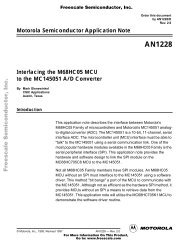ML13135_rev0 - LANSDALE Semiconductor Inc.
ML13135_rev0 - LANSDALE Semiconductor Inc.
ML13135_rev0 - LANSDALE Semiconductor Inc.
Create successful ePaper yourself
Turn your PDF publications into a flip-book with our unique Google optimized e-Paper software.
<strong>ML13135</strong><br />
<strong>LANSDALE</strong> <strong>Semiconductor</strong>, <strong>Inc</strong>.<br />
CIRCUIT DESCRIPTION<br />
The <strong>ML13135</strong> is a complete dual conversion receiver. This<br />
includes two local oscillators, two mixers, a limiting IF amplifier<br />
and detector, and an op amp. It will provide a voltage<br />
buffered RSSI with 70 dB of usable range, isolated tuning<br />
diode and buffered LO output for PLL operation, and a separate<br />
VCC pin for the first mixer and LO. Improvements have<br />
been made in the temperature performance of both the recovered<br />
audio and the RSSI.<br />
VCC<br />
Two separate V CC lines enable the first LO and mixer to<br />
continue running while the rest of the circuit is powered down.<br />
They also isolate the RF from the rest of the internal circuit.<br />
Local Oscillators<br />
The local oscillators are grounded collector Colpitts, which<br />
can be easily crystal–controlled or VCO controlled with the<br />
on–board varactor and external PLL. The first LO transistor is<br />
internally biased, but the emitter is pinned–out and IQ can be<br />
increased for high frequency or VCO operation. The collector<br />
is not pinned out, so for crystal operation, the LO is generally<br />
limited to 3rd overtone crystal frequencies; typically around 60<br />
MHz. For higher frequency operation, the LO can be provided<br />
externally as shown in Figure 16.<br />
Buffer<br />
An amplifier on the 1st LO output converts the single–ended<br />
LO output to a differential signal to drive the mixer. Capacitive<br />
coupling between the LO and the amplifier minimizes the<br />
effects of the change in oscillator current on the mixer.<br />
Buffered LO output is pinned–out at Pin 3 for use with a PLL,<br />
with a typical output voltage of 320 mVpp at VCC= 4.0 V and<br />
with a 5.1 k resistor from Pin 3 to ground. As seen in Figure<br />
14, the buffered LO output varies with the supply voltage and<br />
a smaller external resistor may be needed for low voltage operation.<br />
The LO buffer operates up to 60 MHz, typically. Above<br />
60 MHz, the output at Pin 3 rolls off at approximately 6.0 dB<br />
per octave. Since most PLLs require about 200 mVpp drive, an<br />
external amplifier may be required.<br />
Mixers<br />
The first and second mixer are of similar design. Both are<br />
double balanced to suppress the LO and input frequencies to<br />
give only the sum and difference frequencies out. This configuration<br />
typically provides 40 to 60 dB of LO suppression. New<br />
design techniques provide improved mixer linearity and third<br />
order intercept without increased noise. The gain on the output<br />
of the 1st mixer starts to roll off at about 20 MHz, so this<br />
receiver could be used with a 21 MHz first IF. It is designed<br />
for use with a ceramic filter, with an output impedance of 330<br />
Ω. A series resistor can be used to raise the impedance for use<br />
with a crystal filter, which typically has an input impedance of<br />
4.0 kΩ. The second mixer input impedance is approximately<br />
4.0 kΩ; it requires an external 360 Ω parallel resistor for use<br />
with a standard ceramic filter.<br />
Limiting IF Amplifier and Detector<br />
The limiter has approximately 110 dB of gain, which starts<br />
rolling off at 2.0 MHz. Although not designed for wideband<br />
operation, the bandwidth of the audio frequency amplifier has<br />
been widened to 50 kHz, which gives less phase shift and<br />
enables the receiver to run at higher data rates. However, care<br />
should be taken not to exceed the bandwidth allowed by local<br />
regulations.<br />
The <strong>ML13135</strong> is designed for use with an LC quadrature<br />
detector, and does not have sufficient drive to be used with a<br />
ceramic discriminator. The discriminators and the external<br />
matching circuit will affect the distortion and recovered audio.<br />
RSSI/Op Amp<br />
The Received Signal Strength Indicator (RSSI) on the<br />
<strong>ML13135</strong> has about 70 dB of range. The resistor needed to<br />
translate the RSSI current to a voltage output has been included<br />
on the internal circuit, which gives it a tighter tolerance. A<br />
temperature compensated reference current also improves the<br />
RSSI accuracy over temperature. On the <strong>ML13135</strong>, the op amp<br />
is not connected internally and can be used for the RSSI or as<br />
a data slicer (see Figure 17c).<br />
600<br />
Figure 14. Buffered LO Output Voltage<br />
versus Supply Voltage<br />
500<br />
RPin3 = 3.0 kΩ<br />
O UTPUT (mV p p<br />
)<br />
400<br />
300<br />
RPin3 = 5.1 kΩ<br />
200<br />
100<br />
2.5 3.0 3.5 4.0 4.5 5.0 5.5<br />
VCC, SUPPLY VOLTAGE (Vdc)<br />
Page 6 of 11 www.lansdale.com<br />
Issue 0






